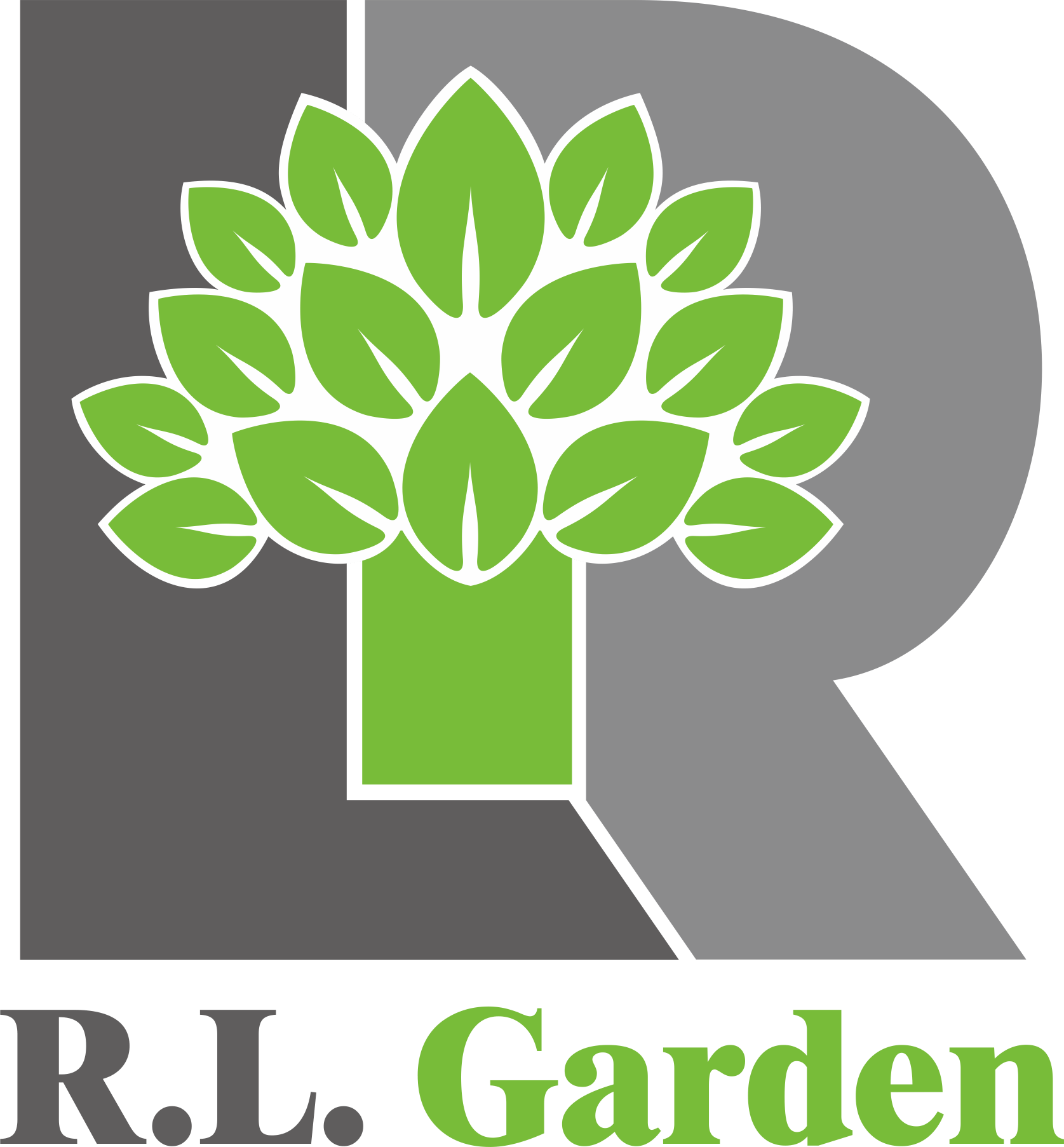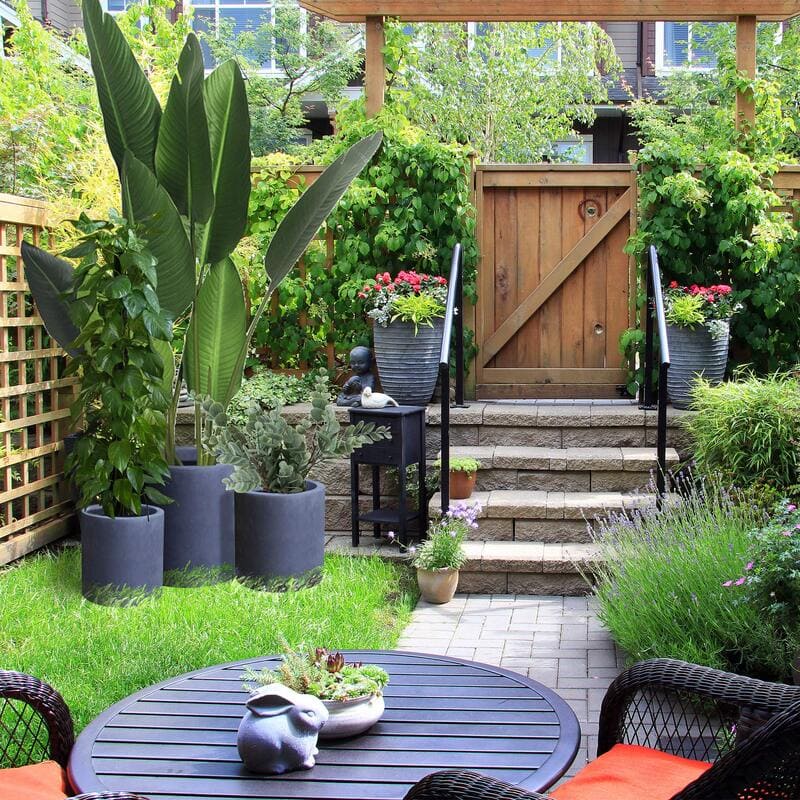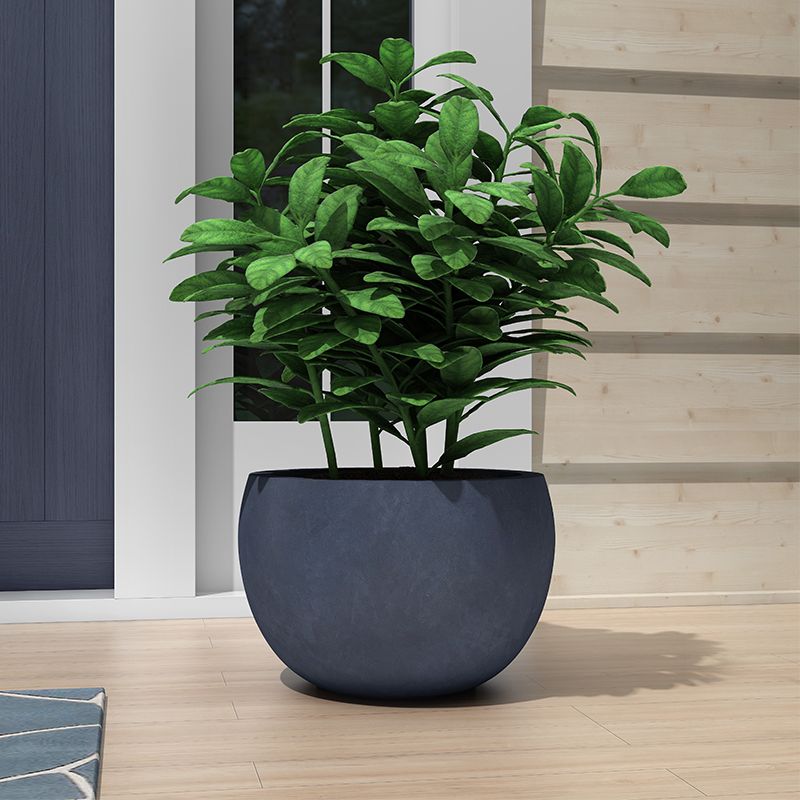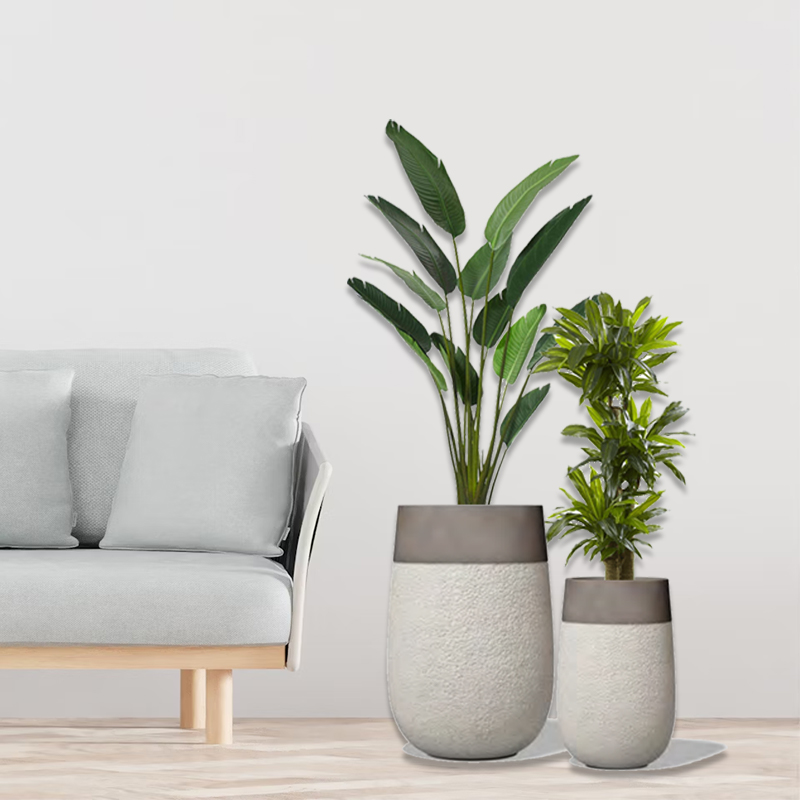Concrete planters: Pioneers in the innovation revolution of indoor green space
First, an overview of the innovation of concrete planters
1.1 Definition and origin of concrete planter
The definition and origin of concrete flowerpots and planters, as the vanguard of the innovation revolution in indoor green space, can be traced back to the mid-20th century, when concrete, as a multi-purpose building material, began to be used by designers to create interior decorative elements. The origin of the concrete planter is closely linked to the development of modern architecture and interior design, which not only reflects the progress of materials science, but also reflects the growing concern for indoor landscaping and ecological sustainability. The emergence of concrete flowerpot has brought new vitality and vitality to the indoor space. It can not only carry plants, but also perfectly integrate with modern architectural style to create both practical and beautiful indoor environment. For example, in the modernist architectural movement of the 1960s, concrete flowerpots became an indispensable part of interior design with their simple lines and solid structure. As the famous architect Louis Kahn said, "Architecture is a play of light and space." The concrete planter is the perfect embodiment of this concept, bringing harmony of light and shadow, as well as a sense of layering, to the interior space through its unique materials and design.
1.2 History of the application of concrete planters in interior design
The history of concrete planters as an interior design element dates back to the mid-20th century, when concrete began to be widely used in architecture and interior design as a durable and cost-effective material. In the 1950s, with the rise of modernist architecture, concrete planters began to appear in commercial and public Spaces, adding an industrial aesthetic to the interior environment. Famous architect Louis Kahn, for example, used concrete planters in his design of the Salke Institute for Biology to create a harmonious coexistence of nature and architecture. Over time, the design of concrete planters gradually shifted from being purely utilitarian to artistic, and designers began to explore different shapes, textures and colors to adapt to changing interior design trends.
In the 21st century, as people pay more attention to the quality of the indoor environment, the application of concrete flowerpots in interior design is also gradually combined with the concept of ecology and sustainability. In 2008, for example, Dutch designer Rem Koolhaas used concrete planters to create a vibrant indoor garden when he designed the Prada Foundation, which not only beautifies the space but also improves the air quality. In addition, the innovative design of the concrete planter is also reflected in its harmonious integration with the interior space, where the designers have integrated the concrete planter into the interior landscape design by simulating the natural environment to create indoor green Spaces that are both practical and beautiful.
When analyzing the history of the application of concrete flowerpots in interior design, it is not difficult to find that it not only reflects the evolution of interior design styles, but also reflects society's growing concern for environmental sustainability. The innovation of concrete flowerpot lies in its ability to perfectly combine functionality and aesthetics, bringing new vitality to the interior space. As architect Frank Lloyd Wright said, "Form follows function." The design and application of concrete planters is a vivid embodiment of this concept, which not only meets the demand for green plants in the interior space, but also becomes an indispensable innovative element in the interior design.
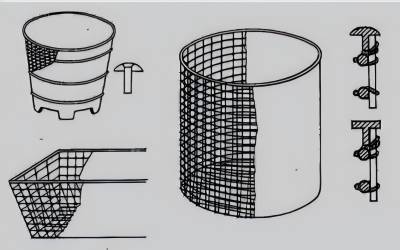
Construction of Planter
Second, Material and design characteristics of concrete planters
2.1 Environmental properties and sustainability of concrete
As a pioneer in the innovation revolution of indoor green space, concrete flowerpot's environmental protection properties and sustainability are one of its core competitiveness. Concrete as a building material, its main components include cement, water, sand and stone, most of these materials come from nature, and can achieve low emissions in the production process. For example, industrial byproducts such as blast furnace slag and fly ash can be used as alternative materials for concrete, which not only reduces the dependence on natural resources, but also reduces carbon emissions. According to studies, the use of these industrial by-products can reduce carbon dioxide emissions by up to 20 percent. The sustainability of concrete planters is also reflected in their durability. They can withstand long periods of use without losing their beauty and functionality, thus reducing the frequency of replacement and waste generation.
In interior design, the environmental properties of concrete planters are not only limited to the material itself, but also include the sustainability of its design. Through innovative design, the designers have made the concrete planter harmoniously integrated with the interior space, creating a green space that is both beautiful and practical. For example, by using a modular design, concrete planters can be easily combined and reorganized to suit the needs of different Spaces and plants, and this flexibility reduces the reliance on new products and prolongs the service life of products. In addition, the surface treatment technology of concrete planters is also improving, such as the use of ecological coatings and natural stone finishes, further enhancing its environmental protection properties.
The environmental properties and sustainability of concrete planters are also reflected in the improvement of indoor air quality. Plants absorb carbon dioxide and release oxygen through photosynthesis. As a carrier of plants, concrete flowerpots not only provide soil for plants to grow, but also absorb indoor harmful substances, such as formaldehyde and benzene, so as to purify the air. One study has shown that houseplants can reduce the concentration of harmful substances in indoor air by up to 50 percent. Therefore, the application of concrete planters in indoor green Spaces not only beautifies the environment, but also provides people with a healthier living space.
2.2 Diversified design and customization of concrete flowerpot
The diversified design and customization of concrete flowerpot is an important embodiment of its revolutionary innovation in indoor green space. This type of planter is not only environmentally friendly and sustainable in material, but also designed to meet the individual needs of different indoor Spaces. Concrete planters, for example, can be customized in different shapes, sizes and colors according to the interior design style, thus blending harmoniously with the surrounding environment. In a study of commercial Spaces, customized concrete planters were shown to enhance customers' shopping experience and increase stay time, thereby indirectly improving the economics of commercial Spaces. In addition, the customization of concrete planters is also reflected in its functionality, such as built-in irrigation system or automatic watering device, these innovative designs not only facilitate the maintenance of plants, but also make concrete planters an efficient tool for indoor green space management. As famed architect Louis Kahn said, "Design is not about creating form, it's about creating relationships." The design and customization of concrete flowerpot is precisely to create a harmonious relationship with the interior space, and at the same time, promote the innovation revolution of the interior green space.
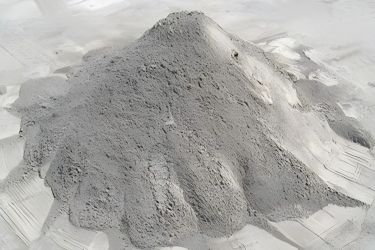
Portland Cement
Third, the role of concrete planters in indoor green space
3.1 Improve indoor air quality and beautify the environment
As a pioneer in the innovation revolution of indoor green space, concrete planters not only enhance the beauty of the indoor environment with their unique material properties and design aesthetics, but also bring substantial health benefits to living and working Spaces by promoting the improvement of indoor air quality. Studies have shown that indoor plants are able to absorb harmful substances in the air, such as formaldehyde, benzene and ammonia, while releasing oxygen, thus effectively reducing indoor pollution levels. For example, NASA found in its "Clean Air Study" that certain houseplants are able to remove up to 87% of air toxins within 24 hours. Concrete POTS are not only robust and durable as carriers for these plants, but their natural texture and color can contrast sharply with the plant's green color, creating a harmonious and vibrant interior landscape.
When it comes to beautifying the environment, the design variety and customizability of concrete planters make them a trump card in the hands of interior designers. Designers can choose concrete planters in different shapes, sizes, and colors to achieve the best visual effect, depending on the size of the space, lighting conditions, and decorating style. For example, a large concrete flowerpot can be placed in a spacious commercial space as a visual focal point, while a small and delicate flowerpot is suitable for placing in a home environment to add spice to life. In addition, the sustainability of concrete planters is also in line with the concept of modern green design, its durability and recyclability reduce the impact on the environment, while providing a guarantee for the long-term beautification of the interior space.
3.2 Harmonious integration of concrete planter with interior space
As the pioneer of the innovation revolution of indoor green space, the harmonious integration of concrete flowerpot with indoor space is not only reflected in visual aesthetics, but also in the improvement of indoor environmental quality. Taking a study as an example, indoor plants can absorb harmful substances in the air, such as formaldehyde, benzene, etc., and concrete flower POTS, as the carrier of plants, are not only stable and durable, but also can seamlessly connect with modern interior design style. For example, in a high-end commercial office space, the designer used customized concrete planters, which not only complement the minimalist design style of the space, but also achieve efficient maintenance of the plants through the built-in water circulation system, thus creating an office environment that is both beautiful and healthy. In addition, the sustainable material properties of the concrete planters are also in line with the current concept of green building and sustainable development. As architect Frank Lloyd Wright said, "Architecture should live in harmony with nature", the concrete planters are the perfect embodiment of this concept.
Fourth,Case analysis of innovative application of concrete planters
4.1 Application of concrete flowerpot in commercial space
In commercial space, the application of concrete planters is becoming the vanguard of the innovation revolution in indoor green space. A well-known New York design firm, for example, incorporated concrete planters into their office space design, which not only improved indoor air quality, but also significantly enhanced employee job satisfaction. Studies have shown that indoor plants can absorb harmful substances in the air, such as formaldehyde, benzene, etc., while concrete flowerpots, as the carrier of plants, provide a good growing environment for plants with their breathability and stability. According to an environmental psychology study, the presence of green plants can reduce the stress level of employees and improve work efficiency. The introduction of concrete flowerpots not only beautifies commercial space, but also indirectly promotes the improvement of business efficiency by improving environmental quality.
4.2 Innovative design of concrete flowerpot in home environment
In the home environment, the innovative design of concrete flower POTS not only provides a new perspective for the revolutionary change of indoor green space, but also brings a different living experience to the occupants through its unique material characteristics and design aesthetics. As a durable and sustainable material, the environmental properties of concrete are fully reflected in the interior design. For example, industrial waste can be used in the production of concrete planters, reducing the environmental impact. In terms of design, the variety and customisation of concrete planters allows them to coexist harmoniously with a variety of interior styles, from minimalism to modern country and even industrial, concrete planters can find their proper place.
Taking innovative design as an example, the application of concrete planters in the home environment has gone beyond the function of traditional plant containers. They can be designed as multi-functional furniture with storage space, or combined with smart home systems for automatic watering and environmental monitoring. In a study of urban households, more than 60 percent of respondents said they were more inclined to choose houseplant containers with innovative designs and added features. This not only improves indoor air quality, but also adds a sense of art and practicality to living Spaces.
The innovative design of the concrete planter in the home environment is also reflected in its harmonious integration with the interior space. Designers take advantage of the plasticity of concrete to create flowerpots in a variety of shapes, from geometric to organic, from smooth surfaces to rough textures, which not only beautify the environment, but can also be optimized for the growing needs of the plant. For example, some designs take into account the space for the plant's root system, allowing the plant to grow better while maintaining the beauty of the pot. As famed architect Louis Kang said, "Design is the process of problem solving." The design of concrete planter is an innovative solution to the problem of indoor green space.
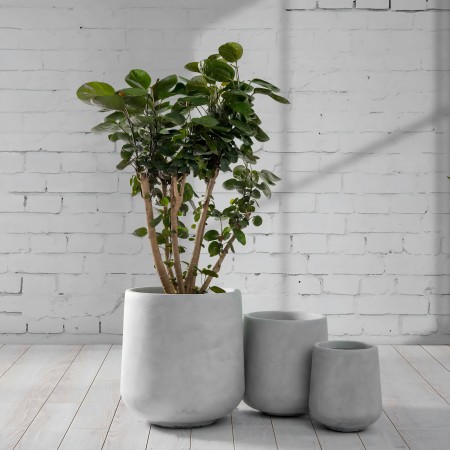
Ronglin's Indoor Concrete Planters
Fifth, the future development trend of concrete planters
5.1 The impact of technological innovation on the design of concrete planter
With the continuous progress of science and technology, the design of concrete flowerpot is undergoing a revolutionary change. Technological innovation not only gives concrete flowerpot more abundant appearance and function, but also greatly improves its application value in indoor green space. For example, by introducing 3D printing technology, designers are able to create unprecedentedly complex geometric shapes and structures that are not only aesthetically pleasing, but can also be optimized according to the needs of plant growth, thus improving the survival rate and growth rate of plants. In addition, the application of smart materials enables concrete planters to automatically adjust water supply in response to environmental changes, such as temperature and humidity, ensuring optimal growth conditions for plants. In a study of commercial Spaces, offices with smart concrete planters improved indoor air quality by 15 percent over those with traditional planters, resulting in a corresponding increase in employee productivity and satisfaction. As architect Frank Lloyd Wright said, "Architecture is not only about shelter, it should also live in harmony with nature." The innovative design of the concrete planter is a modern interpretation of this idea, which not only beautifies the interior environment, but also promotes harmonious coexistence between man and nature.
5.2 The potential role of concrete flowerpots in green buildings
The potential role of concrete planters in green buildings is multifaceted, not only as an interior decoration element, but also carries the mission of improving the quality and sustainability of the built environment. Taking data as an example, studies have shown that houseplants are able to absorb harmful substances in the air, such as formaldehyde, benzene, etc., and release oxygen to improve indoor air quality. As a carrier for plants, concrete POTS are further strengthened by the environmental properties and sustainability of their materials. For example, concrete flowerpots made from recycled materials not only reduce the burden on the environment, but also promote the growth of plant roots through their rough surface, thus improving the survival rate and beauty of plants.
In the design of green buildings, the diverse design and customisation of concrete planters make them a model for innovative applications. For example, certain building projects feature concrete planters with modular designs that can be adjusted to the size of the space and light conditions to maximize the growth potential of the plants. This design not only enhances the aesthetics of the interior space, but also helps regulate the indoor temperature and reduce energy consumption through the photosynthesis of the plants. As architect Frank Lloyd Wright said, "Architecture is not only about shelter, it should also live in harmony with nature." Concrete planter is the practitioner of this concept, which perfectly blends natural elements with architectural Spaces to provide a healthier and more comfortable living environment for its occupants.
The influence of technological innovation on the design of concrete flowerpot can not be ignored. With the development of 3D printing technology, designers are able to create more complex and fine concrete flowerpot forms that are not only beautiful, but can also be optimized according to the growth needs of plants. For example, certain 3D printed concrete flowerpots are designed with special drainage and ventilation structures, which contribute to the healthy growth of plant roots while reducing maintenance costs. In the future trend of green building, this combination of technology and design will propel concrete planters to the vanguard of an innovation revolution in indoor green Spaces, as William MacDonald, a sustainable building expert, says: "The future of architecture lies in symbiosis with nature." Concrete planters are the bridge to this symbiosis.
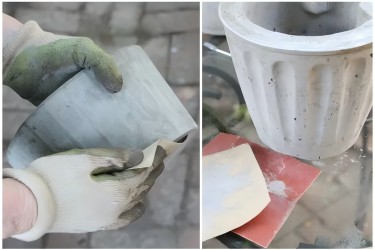
DIY handcraft concrete planters
Sixth. Conclusion and Prospect
6.1 Contribution of concrete flowerpot to indoor green space revolution
As a pioneer in the innovation revolution of indoor green space, the contribution of concrete planter is not only reflected in the environmental protection properties and sustainability of the material, but also in the diversification and customization of its design, which brings unprecedented aesthetic experience and ecological benefits to the indoor space. According to research, indoor plants can absorb harmful substances in the air, such as formaldehyde, benzene, etc., and concrete flowerpots as a plant carrier, its breathability and stability provide a good growth environment for plants, and then effectively improve indoor air quality. For example, in a study of office environments, employees in areas where plants and concrete planters were introduced experienced an increase in productivity and satisfaction. In addition, innovative use cases of concrete planters have shown that they can be harmoniously integrated with interior design in both commercial and home environments, creating green Spaces that are both functional and beautiful. For example, a well-known coffee chain not only enhanced its brand image by placing customized concrete planters in its stores, but also provided customers with a more comfortable and natural dining environment. The future development trend of concrete planters indicates that technological innovation will further promote the diversification of design, and at the same time, with the rise of green buildings, concrete planters will play an increasingly important role in it, becoming an integral part of the indoor green space revolution.
6.2 Expectations for future interior design and green space innovation
With the acceleration of urbanization, the green revolution of interior space is particularly important. As the vanguard of this revolution, concrete flowerpots not only provide new possibilities for interior design with their unique environmental properties and sustainable materials, but also play a key role in improving indoor air quality and beautifying the environment. According to research, indoor plants can absorb harmful substances in the air, such as formaldehyde, benzene, etc., while releasing oxygen to improve indoor microclimate. Concrete planters are ideal for indoor green space design due to their durability and ease of maintenance. For example, a well-known commercial space adopts concrete flowerpot design, which not only improves the ecological benefits of the space, but also attracts customers through its unique design style, becoming a model of commercial space design. In the future, with the continuous progress of technological innovation, the design of concrete flower POTS will be more diversified, and its role in green buildings will be more prominent, which is expected to become an important driving force for interior design and green space innovation.
